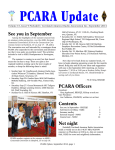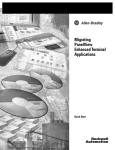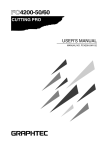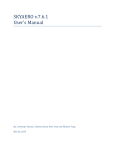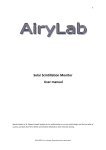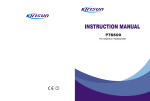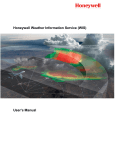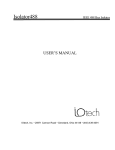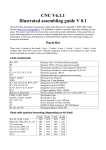Download Druck DPI 140/141 - GE Measurement & Control
Transcript
GE Sensing & Inspection Technologies Druck DPI 140/141 Precision Pressure Indicators User manual K0023 g © The General Electric Company. All rights reserved Druck DPI 140 Series User Manual SAFETY This publication contains information and warnings which must be followed for safe operation and to maintain the equipment in a safe condition. Use qualified* personnel and good engineering practice for all procedures in this publication. The operator must not use this equipment for any other purpose than that stated. Do not apply a pressure greater than the maximum pressure stated. * A qualified person must have attended a product training course given by the manufacturer or appointed agent and successfully completed the training course on this equipment SOFTWARE ISSUE NUMBERS This publication is correct for the following software issue numbers. If the software has a different issue number, this publication may not contain the correct description or procedures. Refer to the manufacturer for further information. Handbook K023 Issue 6 Software Numbers DPI 140 DK 36 Issue 5 DPI 141 DK 123 Issue 1 This product meets the essential protection requirements of the relevant EEC directives. Further details of applied standards may be found in the product specification. This symbol, on the instrument, indicates that the user should refer to the user manual. The following symbols and markings apply to this instrument. This symbol, on the instrument, indicates that the user should refer to the user manual. This symbol, on the instrument or in the manual, indicates a risk of electric shock. K023 Issue No.7 i Druck DPI 140 Series User Manual Abbreviations NOTE: Abbreviations are the same in the singular and plural. abs BS °C contd CR DIN DPI DVM EPROM FS ft Gnd Hz ICAO IEC LED LSB in Hg abs IEEE 488 kg kÙ kPa mA max min MΩ mbar mm mmHg MSB -ve Ω PCB psi +ve REN LED RH RMS RS232 RV SW U.K. V V V a.c. V d.c. K023 Issue No.7 absolute British Standard degrees Celsius continued carriage return Deutsche Industrie Norm (German Industry Standard) digital pressure indicator digital volt meter erasable programmable read only memory full-scale feet ground (earth) Hertz International Civil Aviation Organisation International Electrical Council light emitting diode least significant bit absolute pressure in inches of mercury Institute of Electrical and Electronic Engineers standard 488 for parallel data transfer kilogram kilo-Ohm kilo-Pascal milli-Ampere maximum minimum or minute mega-Ohm millibar millimetre millimetre of mercury most significant bit negative Ohm printed circuit board pound per square inch positive remote enable light emitting diode relative humidity root mean square serial data transmission standard variable resistor switch United Kingdom version Volt Volts alternating current Volts direct current ii Druck DPI 140 Series User Manual Abbreviations used in Remote Control Term Explanation Term Explanation AH CTS DC DT DTR LE LF acceptor handshaking clear to send device clear data trigger data terminal ready listener extension line feed PP RTS RxD SH SRQ TE TxD parallel poll request to send received data source handshaking service request talker extension transmitted data K023 Issue No.7 iii Druck DPI 140 Series User Manual CONTENTS 1 INTRODUCTION ...................................................................................................... 1 2 2.1 2.2 2.3 2.4 INSTALLATION ....................................................................................................... 2 Power supply ..............................................................................................................2 Pneumatic supply .................................................................................................... 4 Panel Mounting ........................................................................................................ 4 Cleaning .................................................................................................................. 5 3 3.1 3.2 OPERATION ............................................................................................................ 6 Local Control Mode ....................................................................................................6 Remote control ......................................................................................................... 6 RS232 Remote Control ................................................................................... 6 IEEE 488 Option .......................................................................................... 10 4 4.1 4.2 4.3 4.4 OPTIONS ................................................................................................................ IEEE 488 (Option A) ............................................................................................... Altitude Display (Option B) ...................................................................................... Panel Mounting (Option C) .................................................................................... Analogue Output (Option D) ................................................................................... 16 16 16 16 16 5 5.1 5.2 5.3 5.4 5.5 5.6 CALIBRATION ....................................................................................................... Preparation .............................................................................................................. Procedure ............................................................................................................... RESET Command ................................................................................................... Automatic Calibration Mode .................................................................................... Calibration Standard ............................................................................................... Calibration of the Analogue Option ......................................................................... 17 17 18 19 19 19 20 6 FAULT FINDING .................................................................................................... 20 APPENDIX A - HUMIDITY OF PRESSURE MEDIUM .................................................... APPENDIX B - SPECIFICATIONS .................................................................................. ANNEX 1 PARALLEL DIGITAL OUTPUT ..................................................................... ANNEX 2 REPEATER INSTRUMENT .......................................................................... K023 Issue No.7 iv 21 23 26 27 Druck DPI 140 Series User Manual DRUCK DPI 140 and 141 SERIES PRECISION PRESSURE INDICATORS 1 INTRODUCTION The Druck DPI 140 precision, pressure indicator utilises a vibrating-cylinder pressure sensor providing pressure readings between 0 and 3.5 bar absolute. Depending on the specific scale values, the display shows a reading up to 999999. The instrument is housed in a lightweight case to DIN standard 43700 and can be supplied for panel mounting. Pressure connection is located on the rear panel. The instrument is supplied, as standard, with a RS232 data interface; as an option an IEEE 488 interface can also be provided. Two output options are available parallel digital output and analogue output. A further option enables the instrument to display the non-linear pressure parameters of altitude. The selection of pressure or altitude is achieved via the instrument front panel or the IEEE 488 interface. The Druck DPI 141 precision, barometric pressure indicator utilises a Druck resonant pressure transducer providing pressure readings between 800 and 1150 mbar absolute. The facilities and options for this instrument are the same as the DPI 140 instrument. The specifications for these instruments are contained in Appendix B. K023 Issue No. 7 1 2 INSTALLATION This instrument can be used on a workbench surface or, with option C, panel mounted. Before use make sure the instrument is set for the power supply voltage and has the necessary pneumatic connection. 2.1 Power Supply This instrument can be powered from 100 to 130 V a.c. or 200 to 260 V a.c. CAUTION: BEFORE SWITCHING ON, CHECK THAT THE POWER SUPPLY VOLTAGE IS CORRECT FOR THE VOLTAGE SETTING OF THE INSTRUMENT. Voltage Setting To change the power supply voltage setting, switch OFF the power supply and disconnect the instrument. Select the supply voltage switch, on the rear panel, to the required voltage setting. Connect the power supply to the instrument. Check that the power supply voltage is correct for the voltage setting and switch the instrument “ON”. Power Connection WARNINGS 1 2 3 4 VOLTAGES, IN EXCESS OF 30 VOLTS (RMS) AC OR 50 VOLTS DC CAN, IN CERTAIN CIRCUMSTANCES, BE LETHAL. CARE MUST BE TAKEN WHEN WORKING ON LIVE EXPOSED CONDUCTORS. THIS INSTRUMENT MUST BE GROUNDED/EARTHED VIA PROTECTIVE GROUND CONDUCTOR OF THE POWER SUPPLY CABLE. ISOLATE THE POWER SUPPLY BEFORE CONNECTING THE INSTRUMENT. ISOLATE THE POWER SUPPLY BEFORE REMOVING THE INSTRUMENT COVERS. EMC WARNING The equipment is designed for use in a Class A industrial environment. In a domestic environment this product may cause radio interference in which case the user may be required to take adequate measures. 1 2 CAUTIONS USE THE CORRECT POWER SUPPLY SETTINGS. OPERATING VOLTAGE RANGES ARE MARKED ON THE REAR PANEL OF THE INSTRUMENT AND DETAILED IN THE SPECIFICATION. TO COMPLY WITH SAFETY STANDARDS THE VOLTAGE LABEL MUST BE CHANGED IF THE POWER SUPPLY VOLTAGE IS CHANGED. The power supply connector is a 3 pole connector to BS4491 (IEC 320). The power must be supplied by a three core cable installed as follows: Brown Live Blue Neutral Green/Yellow Earth (Ground) The power supply, 500 mA, 20 mm, anti-surge fuse is in the live circuit and locates in the rear panel. K023 Issue No. 7 138 20 MIN from edges 17 min from edge 40 min between cut-outs CUT-OUT 17 min between cut-outs 8 max panel thickness instrument M4 fixings CLAMP B-A3-0356-1 Druck DPI 140 Series User Manual Figure 1, Panel Cut-out 3 Druck DPI 140 Series User Manual 2.2 Pneumatic Supply To operate this instrument as a barometer, no connection is required. When measuring a source pressure, the connections are detailed below, the source must only be clean dry air. The DPI 141 instrument is only intended for use as a barometer. Pneumatic Connection The connection port on the rear panel is identified as the MEASURE port. The connection is a G¼ (female) port and requires sealing with a bonded washer. 2.3 Panel Mounting (Figure 1) A panel mounted instrument must have the rubber feet removed so that it slides though a DIN standard 186 x 138 mm cut-out. Alternatively, one or two instruments can be mounted in a standard 19" equipment rack. It is important that a free circulation of air is available for instruments mounted in panels. Mounting Brackets To fit option C brackets, unscrew and remove the six screws securing the instrument case to the chassis. 1. Withdraw the case, unscrew the two screws securing each foot to the case. 2. Remove the two rubber plugs from the top of the case. 3. Locate the two pins of the first bracket in the two holes in the top of the case. 4. Locate the two pins of the second bracket in the forward two holes left by the screws securing the forward feet. 5. Using the two screws, secure the two brackets together. Installing in a Panel Cut-out The fitting of the instrument into a panel cut-out requires the assembled instrument case to be secured to the panel and tensioned by the jack screws. 1. Depending on accessibility, connect the instrument before or after fitment into the case. If the instrument’s electrical power switch cannot be easily accessed ensure a separate, accessible isolating switch is installed. 2. Carefully refit the instrument chassis into the case and secure with the six screws. K023 Issue No. 7 4 Druck DPI 140 Series User Manual Installing in a Standard 19" Equipment Rack The fitting of the instrument into a standard 19" equipment rack requires the assembled instrument to be secured to the panel by the four drilled lugs of the mounting brackets. 1. Carefully refit the instrument chassis into the case and secure with the six screws. 2. Secure the instrument into the equipment rack. 3. If the instrument’s electrical power switch cannot be easily accessed install a separate, accessible isolating switch. 2.4 Cleaning Clean the instrument case with a damp cloth and mild detergent. K023 Issue No. 7 5 Druck DPI 140 Series User Manual 3 MANUAL OPERATION 3.1 Local Control Mode When the instrument is switched on the POWER LED illuminates and the display shows the pressure applied to the MEASURE port. Full accuracy is achieved after a recommended warmup period of 15 minutes. 3.2 Remote Control RS232 Remote Control Mode The remote control mode enables the current pressure reading to be sent to a computer, VDU or printer. The reading can be obtained either on demand, automatically or at a rate of twice every reading update. This mode also provides the link to the automatic calibration equipment. The rear panel connector identified SERIAL INTERFACE provides connection for the RS232 communication the pin identifications are as follows: Pin 2 Pin 3 Pin 4 Pin 5 Pin 7 Pin 20 - TXD Transmitted data from the instrument RXD Received data to the instrument RTS Request to send from the instrument CTS Clear to send to the instrument GND Signal ground (0V) DTR Data Terminal Ready from the instrument, connected to +12V via 475 Ω. Ω Figure 2 RS232 Connections K023 Issue No. 7 6 Druck DPI 140 Series User Manual Data Flow Control Both software and hardware handshakes are implemented, with a selectable baud rate. Software Handshake Pins 4 and 5 (RTS and CTS) are not connected which reduces the number of connections to the instrument. The XON and XOFF commands will be acted on as soon as they are received by the instrument. The XON command will be passed out first and then the data transmission will continue. On receiving a XOFF command, all data will be halted but the XON command will be passed on. Hardware Handshake Hardware handshaking is implemented using the RTS/CTS pins on the 25-way D-Connector. When data is ready to be transmitted, the instrument activates the request to send (RTS) pin (+12V) and then waits for the clear to send (CTS) signal, pin (>+3V) before commencing transmission. CTS may be left disconnected as it has an internal “pull-up” resistor. NOTE: If CTS is taken low during transmission, there may be a one character overrun due to a character having already been placed in the transmit buffer. Baud Rate and Serial Mode Switch Selection The baud rate is selected by switches SW4-2, SW4-3 and SW4-4. The following table shows the switch positions for the available baud rates. SW4 * Baud -4 -3 -2 0 0 0 0 1 1 1 1 0 0 1 1 0 0 1 1 0 1 0 1 0 1 0 1 9600 150/110* 300 600 1200 2400 4800 9600 110 baud can be internally selected on the PCB when link 1 replaces link 2 and SW4-2 to 4 are set to 150 baud. K023 Issue No. 7 7 Druck DPI 140 Series User Manual Position of SW4 settings for 1200 baud in printer mode. Switch 1 0 -4 -3 -2 -1 SW4-1 selects ‘Printer’ or ‘Computer’ mode. 1 Computer mode (reading on demand) 0 Printer mode (reading twice every update) In the printer mode, the instruments’ baud rate is preset to 1200 during manufacture. The serial data is sent as 1 start bit, 8 data bits with 1 stop bit; the MSB is zero. Computer Mode To select this mode, the mode select switch must be set to the computer mode position (see switch settings). In the computer mode, every time the instrument receives <CR> the current pressure reading is sent to the computer. Preceding characters will be ignored unless they are relevant e.g., entering calibration mode. To indicate that a reading has been requested, the front panel REN LED flashes on. Printer Mode The printer mode is selected by switch SW4-1. When the instrument is in printer mode, each new reading (approximately five per second) is sent to a printer connected to the serial port. The display updates every other reading i.e., approximately 2.5 per second. If the new reading occurs before the last reading can be transmitted, then the new reading will be lost. Subsequent readings are sent if all characters of the old reading have been sent and an XOFF condition does not exist. Output Data Format The output data form is as follows: (sign) (6 digits with floating point) (space) (carriage return) (line feed)* * Line feed is transmitted only when the instrument is in printer mode. K023 Issue No. 7 8 Druck DPI 140 Series User Manual Typical Programming Routine The following BASIC program demonstrates taking readings on demand when the instrument is in computer mode. 10 OPEN ‘SERIAL’ AS FILE #1 Open the RS232 port as File #1 20 PRINT ‘HIT RETURN TO TAKE READING’ 30 INPUT A$ Wait for user keyboard input 40 PRINT #1, ‘ ‘ Send a carriage return to demand reading. 50 INPUT #1, R$ Input reading from RS232 60 PRINT R$ Print input string 70 GOTO 20 Line 10 should be adjusted to suit the computer in use so that file #1 is opened for input and output. K023 Issue No. 7 9 Druck DPI 140 Series User Manual IEEE 488 Option Introduction The IEEE 488 bus system allows up to fifteen instruments to be controlled from a single computer. Each instrument is given a unique “address” by switches or links in the instrument. Using this address the computer sends code over the IEEE 488 bus to demand data from the instrument (TALK mode) or to issue control data to the instrument (LISTEN mode). The IEEE 488 bus system also allows instruments to request “service” by activating the common SRQ (Service Request) line. An instrument, configured for this facility, can signal the occurrence of an error or an end of a pressure conversion cycle. Setting the instrument Transmitted Data Format The data sent following the command to talk consists of one data string which is terminated by CR, LF or CR LF depending on the setting of SW3. The EOI is sent with the last character. The instrument reading and set-point always consists of <sign>, <six digits and one floating point> <space>. Error conditions are indicated by appending <@ 2 digit value><space>, except when disabled by the “@0” code. The complete parameter is left out if there are no errors. Address Switch and Data Output Format The instrument address is set by SW3-1 to SW3-5 on the rear panel, where SW3-1 is the least significant. The address at manufacture is set to 20. SW3-7 and SW3-8 control the end of line format of the data sent. EOI is always sent with the last character. The end of line formats can be selected as follows: SW3-8 SW3-7 Line format 0 0 1 1 0 1 0 1 Reserved LF with EOI CR with EOI CR, LF with EOI The setting at manufacture is: SW3-8 SW3-7 1 1 NOTES 1. 2. SW3-6 is reserved. After changing the switches, the instrument power supply switch must be cycled off and on. K023 Issue No. 7 10 Druck DPI 140 Series User Manual Table 1, Address Switch Settings Address 0 1 2 3 4 5 6 7 8 9 10 11 12 13 14 15 16 17 18 19 20 21 22 23 24 25 26 27 28 29 30 31 example: SW3-5 SW3-4 SW3-3 0 0 0 0 0 0 0 0 0 0 0 0 0 0 1 0 0 1 0 0 1 0 0 1 0 1 0 0 1 0 0 1 0 0 1 0 0 1 1 0 1 1 0 1 1 0 1 1 1 0 0 1 0 0 1 0 0 1 0 0 1 0 1 1 0 1 1 0 1 1 0 1 1 1 0 1 1 0 1 1 0 1 1 0 1 1 1 1 1 1 1 1 1 NOT A VALID ADDRESS SW3-2 0 0 1 1 0 0 1 1 0 0 1 1 0 0 1 1 0 0 1 1 0 0 1 1 0 0 1 1 0 0 1 SW3-1 0 1 0 1 0 1 0 1 0 1 0 1 0 1 0 1 0 1 0 1 0 1 0 1 0 1 0 1 0 1 0 Rear panel switch setting for address 20, sending CR and LF with EOI. Switch 1 0 K023 Issue No. 7 -8 -7 -6 -5 -4 -3 -2 -1 11 Druck DPI 140 Series User Manual Using the IEEE 488 The current instrument reading is obtained by addressing the instrument to “TALK”. The front panel REN LED flashes to show that the instrument has been addressed. The notation of the returned data string is as follows: +x.xxxxx@xx (S)(CR)(LF) 1. x is a numeric digit 0 to 9. 2. Position of the point can vary, but is always after an “x” and is always present. 3. @xx is only sent if there is an error and error reporting is not disabled by a @0 command. 4. The last character before any line terminator is always a space. 5. The line terminator (CR + LF) is programmed by SW3-7 and SW3-8. Table 2, lists the control codes relevant to the instrument. Table 2, IEEE 488 Control Codes Code Action No SRQ interrupts SRQ on error Reserved Reserved SRQ on End of Conversion SRQ on error and on End of Conversion Disable error reporting Enable error reporting I0* I1 I2 I3 I4 I5 @0 @1* * default power-on condition Sending control codes Control codes are obeyed as soon as they are proven valid. If a string contains an error, the remainder of the string will be ignored. Control codes may be grouped together to form a control string. Codes may be separated by spaces or commas to add clarity, but this is not compulsory. The following are examples of valid control strings. @0 I1 @0I1 @0 I1 @1, I1 K023 Issue No. 7 Disable error reporting Set SRQ on error mode Turn off error reporting and set SRQ on error mode As above Turn on error reporting and set SRQ on error mode 12 Druck DPI 140 Series User Manual Received Data Format The instrument responds to control codes in a string provided that there are no spaces within control codes. NOTE: Spaces and commas are allowed between control codes as control code separators. Data in one of the following categories must come after a valid control code: 1 2 3 4 5 Another valid control code A space (ASCII (32)) A comma Carriage return (ASCII (13)) Line feed (ASCII (10)) Sending the wrong code sets error @01, no further action is taken and the rest of the string is ignored. IEEE Specification IEEE Interface Function Requirements The interface meets the IEEE 488 requirements for the following: Code SH1 AH1 T6 L4 TE0 LE0 SR1 PP0 DC0 DT0 K023 Issue No. 7 Interface Function Source handshaking capability Acceptor handshaking capability Talker (basic talker, serial poll, talk only mode, unaddressed to talk if addressed to talk) Basic listener, unaddressed to listen if addressed to talk No address extension talker mode No address extension listener mode Service request capability No parallel poll capability No device clear capability No device trigger capability 13 Druck DPI 140 Series User Manual Serial Poll The instrument responds to a standard IEEE serial poll sequence. The serial poll response byte is as follows: Bit Bit 0-4 Bit 5 Bit 6 Bit 7 Poll Response Error bits End of conversion caused SRQ SRQ bit. Set if the instrument caused the SRQ Reserved Table 3, Serial Poll Response Byte Bit 0 1 2 3 4 5 6 7 K023 Issue No. 7 Response Programming data error Reserved Reserved No new data available error Reserved Reserved 1 if the instrument caused SRQ End of conversion 14 Druck DPI 140 Series User Manual Error Indication Error indication is disabled by sending the @0 code and enabled by sending @1. @1 is default at power on. NOTE: On an error interrupt the @0 code does not affect the SRQ. The addition of “@ value” at the end of the data string indicates an error. The occurrence of the “@” symbol changes the numeric data to an “impure” numeric string, (i.e., a non-numeric character occurs), which may give a convenient error detection process for the controlling computer. This value is a two digit number giving the octal representation of the 6 error functions. Bit Error Bit 0 Bit 1 Bit 2 Bit 3 Programming data error Reserved Reserved Data not ready example: @01 indicates the wrong code sent to the instrument. @10 indicates no new pressure reading available since last reading (only in NO). @11 indicates both @01 and @10. The ‘no new reading available error’ causes an SRQ error interrupt. This error is an indication only and clears when a new reading is available. A new reading is available approximately five times per second. The reading given is the current pressure reading. Service Request (SRQ) in Error Whenever an error occurs with the interrupt parameter set to I1 or I5 the SRQ line signal goes to a low level. The line is then “latched” to a low level until a serial poll occurs or the instrument is next addressed to talk. K023 Issue No. 7 15 Druck DPI 140 Series User Manual 4 OPTIONS 4.1 IEEE 488 (Option A) The IEEE 488 bus system allows up to fifteen instruments to be controlled from a single computer. Details of this option are detailed in the previous section starting on page 12. 4.2 Altitude Display (Option B) This option enables the instrument to display units of altitude (feet or metres) as an alternative to pressure. The conversion of pressure to altitude is based on the BS2G199 (ICAO Law) with separate equations for below and above the Tropopause. The accuracy of the conversion is to within one count on the altitude display. The pressure conversion cycle is slightly lengthened when the altitude display is selected. Operation A switch on the front panel changes the display between altitude and pressure. Two reading updates should be allowed, after changing the switch, before the correct reading is displayed. 4.3 Panel Mounting (Option C) Instruments can be mounted into a panel using a mounting bracket kit for details see 4. 4.4 Analogue Output (Option D) The option is scaled to a maximum output of 10V and zero set at any pressure value within the range of the instrument. The analogue output signal is available at a six-way Greenpar connector on the rear panel. NOTE: If the pressure falls below the set zero value the analogue output will not indicate a negative pressure reading. The output impedance is a nominal 1 kΩ and can be changed by replacing resistor R5 on the PCB to the appropriate value (100 Ω minimum). To calibrate this option see page 20. A 6-way plug supplied with the instrument must be connected as follows: PIN NO. 2 1 K023 Issue No. 7 FUNCTION Analogue Signal Signal Ground 16 Druck DPI 140 Series User Manual 5 CALIBRATION The instrument is equipped with an automatic calibration facility using a pressure standard and a compatible RS232 terminal or computer. The changes in zero and span constants, measured during calibration, are displayed and can be accepted or rejected. The instrument is calibrated during manufacture, including small adjustments using the automatic calibration facility, to meet the specification stated in the data sheet. The instrument uses these calibration values until it receives a RESET command or a further calibration is carried out. 5.1 Preparation The instrument must be connected to a compatible computer using a standard RS232 cable and then set to ‘computer’ mode. The old calibration values remain valid during a calibration and until the new calibration values are accepted. Also, if new calibration values are accepted, it is still possible to revert back to the previously stored calibration values by using the RESET command. Equipment The following equipment is required to calibrate the instrument. Use clean dry air as the pressure medium. NOTE: Equivalent substitutes may be used. Description Usage Pressure standard calibration equipment (AIR) accuracy of at least ±0.01% RS232 computer terminal Calibration Calibration Test Environment Temperature: 20°C (recommended) In standard humidity and atmospheric pressure K023 Issue No. 7 17 Druck DPI 140 Series User Manual 5.2 Procedure The RS232 computer terminal must be set to a baud rate of 4800, 8 bit, no parity. Switch ON and set the RS232 computer terminal in full duplex mode, i.e., no local echo back. All inputs from the RS232 computer terminal to the instrument are in upper-case, depress the caps lock key during the following tests. NOTE: If the RS232 computer terminal has the facility to send a line feed character following every carriage return, the facility must be turned OFF. 1. Connect the power supply as detailed in INSTALLATION and the pressure standard outlet port to the MEASURE port. Connect the RS232 computer terminal to the connector on the rear panel. 2. Switch ON the instrument and the RS232 computer terminal. To enter calibration mode proceed as follows: a. Type: K.<CR> NOTE: Make sure that the full stop is included when selecting calibration mode. b. Wait at least one hour from switch on to stabilize the instrument for optimum accuracy. c. The instrument displays the message “Calibration mode” with a prompt of “Pressure?”. d. Adjust the pressure standard to the pressure value to be applied. When the pressure is stable, enter the pressure value followed by <CR>. The value must be entered in the units of pressure measurement displayed and in the same format as the display e.g., ‘1013.25’. NOTE:: e. The instrument stores and displays three readings at the pressure value entered and prompts for a new pressure value. Between two and ten calibration pressures may be applied. NOTE: f. Only the first 8 characters are recognised. A ‘bad’ character causes the input to be ignored and the instrument displays the prompt of ‘Pressure?’ again. A numeric overflow error will occur if all the pressures are the same or approximately the same. When all the pressure values have been applied and entered, press <CR>. K023 Issue No. 7 18 Druck DPI 140 Series User Manual g. While the instrument microprocessor calculates the new calibration constants the display shows ‘Calculating...’. After the calculations, the instrument displays the change in zero (%FS) and span (%RD) from the previous calibration constants. The new calibration constants can be accepted or rejected. If rejected, the previous calibration constants remain. h. To accept the new calibration, type ‘Y’, any other character will reject the new calibration. 5.3 RESET Command To revert back to the previously stored calibration values the instrument must be in computer mode and receive the RESET command as follows: Type: <R!> When the instrument is using the original calibration, the display will show, for one second after power-up ‘0.0.0.0.0.0.’ instead of a blank display. The same display appears if the latest calibration constants are corrupted. 5.4 Automatic Calibration Mode For automatic calibration mode connect to the RS232 port any standard ASCII computer terminal. With calibration pressures applied, the instrument reads these pressure values and calculates new correction constants. The user can accept or reject the new constants, if accepted, the calibration is automatically updated. If required, reversion to previously stored calibration values can be made. 5.5 Calibration Standard At manufacture this instrument is calibrated against precision calibration equipment which is traceable to the U.K. National Physical Laboratory. K023 Issue No. 7 19 Druck DPI 140 Series User Manual 5.6 Calibration of the Analogue Option To calibrate the instrument carry out the following procedure: 1. Preparation • Remove the instrument case. • Connect the pressure standard and connect the instrument to the power supply. • Connect the DVM to pin 2 (+ve) pin 1 (-ve). PIN NO. FUNCTION 2 1 6 Analogue Signal Signal Ground 2. Zero • Allow a warm-up time of approximately 1 hour. • Apply the base or zero pressure. • Adjust the analogue output signal to zero (0.0000V) by adjusting zero potentiometer RV4 on the PCB. 3. Span • Apply the full-scale pressure. • Adjust the analogue output signal to the full-scale pressure value by adjusting span potentiometer RV3 on the PCB. • Release all the pressure. 4. Completion • Switch the instrument off, disconnect the pressure standard and the power supply. • Refit the instrument case. • Disconnect the DVM. FAULT FINDING If the display shows 0.0.0.0.0.0. for one second before displaying the pressure, the latest calibration data is lost and the instrument uses the original manufacturers calibration data. See the Calibration. K023 Issue No. 7 20 Druck DPI 140 Series User Manual APPENDIX A - HUMIDITY OF PRESSURE MEDIUM 1 DPI 140 Instrument 1.1 Introduction This instrument should be calibrated using clean dry air, errors will occur using moist air. An increase in RH (Relative Humidity) causes an increase of the reading in the form of a span shift. The change in span relative to temperature is non-linear. With a temperature increase the error and the rate of change of error increases. 1.2 Relative Humidity Change The expected error for a change from 0 to 70% RH at various temperatures are as follows: Temperature (°C) 10 25 30 Error (% reading) 0.004 0.010 0.013 The error is approximately proportional to the change in % RH. Excessive errors may result from moisture entering the transducer and condensing on the internal surfaces. It is recommended that the tubing used in the system connected to the instrument is metal or polythene. Materials such as rubber or nylon retain moisture and under low air/gas pressures release moisture increasing the relative humidity of the air. Before calibrating with dry air, the system should be purged to remove any moisture. 2 DPI 141 Instrument 2.1 Introduction This instrument should be calibrated using clean dry air. RH (Relative Humidity) does not cause any known effect on the calibration of the DPI 141 instrument. K023 Issue No. 7 21 APPENDIX A Druck DPI 140 Series User Manual APPENDIX B - SPECIFICATIONS This page shows the common DPI 140 series specification details. Individual instrument details are contained on the following pages. Power supply Voltage selection (switch selected on the rear panel) ..................................................................................................... 100 to 130V a.c. ................................................................................................. or 200 to 260V a.c. Frequency range .................................................................................................... 50 - 400 Hz Power ............................................................................................................ 30 VA (max) Electrical safety This instrument meets: ................................................................................ BS EN 61010-1 as applicable Electromagnetic compatibility This instrument meets: .......................................................................................... EN50081-1 (emissions) ............................................................................................ EN50082-1 (immunity) Dimensions Weight (nominal) ............................................................................................................. 3kg Dimensions - mm not to scale Instrument Dimensions K023 Issue No. 7 22 APPENDIX B Druck DPI 140 Series User Manual DPI 140 Digital Pressure Indicator Pressure ranges ..................................................................... 35 mbar to 1150 mbar ................................................................................... 35 mbar to 2.6 bar ................................................................................... 35 mbar to 3.5 bar Barometric version ............................................................... 800 mbar to 1150 mbar absolute absolute absolute absolute Display Units Pressure units (one only) ......................................................... bar, kPa, psi, inHg and mmHg Altitude (option) .................................................................................................. feet or metres Resolution Display 0 to 999999 ................................................................................................... 0.01 mbar (1 bar absolute version) Accuracy including temperature effects over 10°C to 30°C, non-linearity, hysteresis and repeatability .................................................................................................. ±0.02% of reading ............................................................................................................ ±0.01% F.S. Barometric version ................................................................................................. ±0.15 mbar (between 800 and 1150 mbar absolute) Altitude Display (BS2G199 (ICAO) equations for below or above the Tropopause) Accuracy of conversion (pressure to altitude) ................................................ one display digit Resolution .................................................................................................................... 0.1 feet ............................................................................................................... 0.1 metres Stability (12 months period, typical value) ............................................................ within 0.005% of F.S. Operating Temperature Calibrated temperature range ................................................................................ 10°C - 30°C Operating temperature range ................................................................................... 0°C - 50°C Update rate RS232/IEEE ...................................................................................................... 5 readings/sec Display ..................................................................................................... 2.5 readings/sec For further details see the data sheet. K023 Issue No. 7 23 APPENDIX B Druck DPI 140 Series User Manual DPI 141 Barometer Pressure range ............................................................................... 800 to 1150 mbar absolute Display Units Pressure units (one only) ................................................................. mbar, psi, inHg or mmHg Altitude (option) .................................................................................................. feet or metres Resolution Display 0 to 999999 (max) ........................................................................................ 0.01 mbar Accuracy including temperature effects over 10°C to 30°C, non-linearity, hysteresis and repeatability, between 800 and 1150 mbar absolute ............................................................................................................. ±0.15 mbar Altitude Display (BS2G199 (ICAO) equations for below or above the Tropopause) Accuracy of conversion (pressure to altitude) ................................................ one display digit Resolution .................................................................................................................... 0.1 feet ............................................................................................................... 0.1 metres Stability (12 months period, typical value) ..................................................... better than 100 ppm/year Operating Temperature Calibrated temperature range .............................................................................. 10°C to 30°C Operating temperature range ................................................................................. 0°C to 50°C Response Sample rate (nominal) ....................................................................................... 4 readings/sec Display update (nominal)................................................................................... 2 readings/sec Average variable .............................................................................between 2 and 50 samples Response over RS232/IEEE 488 Sample rate ................................................................................................. 4 readings/second Variable sample rate (nominal) ................................................................... 4/second to 1/hour For further details see the data sheet. K023 Issue No. 7 24 APPENDIX B Druck DPI 140 Series User Manual ANNEX 1 TO K023 1 PARALLEL DIGITAL OUTPUT 1.1 Introduction This ‘special order’ option provides a parallel digital output for fast updating applications and is scaled by the option software so that 800 - 1150 mbar is equivalent to 0 - 65,535 (decimal). The parallel digital output signals (detailed below) i.e., two 8 bit bytes with LSB and MSB strobes are available on 25-way D-type connector marked ‘Serial Interface’. The RS232 serial data output is also available on this connector as detailed on page . Parallel Digital Output Pin Connections Pin No. 14 15 16 17 18 19 21 22 23 24 K023 Issue No. 7 Function MSD Strobe LSD Strobe DB0 DB1 DB2 DB3 DB4 DB5 DB6 DB7 25 ANNEX 1 Druck DPI 140 Series User Manual ANNEX 2 TO K023 1 REPEATER INSTRUMENT 1.1 Introduction The DPI 140 repeater instrument displays the same pressure reading as a remote DPI 140 instrument when the two instruments are connected by a RS232 cable. The repeater fitted with the IEEE option can operate in the same way when connected by an IEEE cable. 1.2 Operation A second DPI 140 instrument, connected via a RS232 cable to a ‘master’ DPI 140 instrument operates as a repeater instrument. The repeater instrument displays the master instrument pressure reading at an update rate that can be adjusted. To operate the instrument, the baud rates of the master and repeater must be the same (by correctly setting SW4-2, SW4-3 and SW4-4). Also, the master instrument must be set in “printer mode” (SW4-1 set to 0). 1.3 Baud rate The manufacturer’s setting of 1200 baud is recommended. Although the instrument correctly functions at lower baud rates it will not display every new reading. At higher baud rates, the instrument has less noise immunity and distance driving capability. The RS232 cable should be wired as follows: Master Instrument 25-way D Connector Repeater Instrument 25-way D Connector Pin 2 TxD Pin 7 Gnd Pin 3 RxD Pin 7 Gnd 1.4 Display Update Rate A standard DPI 140 produces five readings per second on the serial (RS232) or parallel (IEEE 488) communications system. However, to make the instrument display more readable, the instrument displays only every other reading (i.e., the display is updated five times per two seconds). Settings of Switch SW4-1 On the DPI 140 repeater instrument, SW4-1 controls the display update rate. When SW4-1 is set to 0, every reading received will be displayed. When SW4-1 is set to 1, every second reading received will be displayed. The manufacturer’s setting for the master and repeater DPI 140 instruments display every second reading. K023 Issue No. 7 26 ANNEX 2 Druck DPI 140 Series User Manual ANNEX 2 TO K023 contd 1.5 Display Point Position The decimal point position in the pressure reading display depends on the current selected pressure units. The pressure reading sent via the RS232 or IEEE 488 has a floating point and always displays six digits. To enable the repeater to function as fixed or floating point, the decimal point position can be selected by wire wrap links within the repeater. These are set at manufacture to suit the specified pressure units but can be re-configured as follows:1. Refer to table to obtain required link settings. 2. Remove the instrument case. 3. Remove unwanted wire wrap links from the pins (marked PL7-1-4) (PL7 is slightly off-centre on the board and next to the EPROM IC14). 4. Using a wire wrap tool, install the wire wrap links. Point Position Pins Linked to Pin 4 123456. 12345.6 1234.56 123.456 12.3456 1.23456 Floating NOTE: 3 2 2 and 3 1 1 and 3 1 and 2 None If the number to be displayed is too big for the selected point position, the point will automatically shift. K023 Issue No. 7 27 ANNEX 2 Druck DPI 140 Series User Manual K023 Issue No. 7 28


































